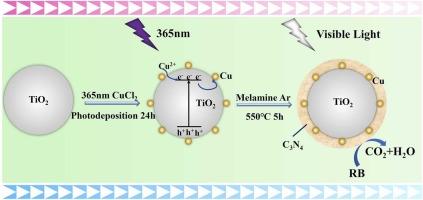利用 g-C3N4 上支持的铜改性 TiO2 在可见光下降解有机污染物
IF 6.3
2区 材料科学
Q2 CHEMISTRY, PHYSICAL
引用次数: 0
摘要
以清洁太阳能为动力的光催化技术已广泛应用于清洁能源生产、生物技术和医药领域。在有机废水处理领域,光催化技术因其快速的反应动力学、最小的废物排放和高选择性而备受关注。虽然人们对传统光催化剂 TiO2 和 g-C3N4 进行了广泛的研究,但它们固有的局限性阻碍了实际应用。本研究通过光沉积和化学气相沉积(CVD)相结合的方法合成了一种新型光催化剂 Cu-TiO2/C3N4。实验结果表明,金属铜原子以单个原子的形式均匀地分散在 TiO2/C3N4 的 Z 型异质结中。在 460 纳米 LED 和 300 瓦氙灯(λ > 400 纳米)照射下,催化剂表现出卓越的光催化性能,在 180 分钟和 105 分钟内降解率分别达到 93.58% 和 98.66%。这些降解率分别是 TiO2 的 2.9 倍和 3.7 倍,g-C3N4 的 5.4 倍和 3.2 倍。此外,与 TiO2/C3N4 相比,Cu-TiO2/C3N4 表现出更高的吸附能力和稳定性,能更有效地吸收和利用可见光。经过七个测试周期后,其性能保持稳定甚至有所提高,最终降解率达到 99.76%。总之,Cu-TiO2/C3N4 的 Z 型异质结结构有效地增强了光生电荷载流子的分离,使其具有优异的可见光光催化活性和稳定性,非常适合于降解水环境中的有机污染物。本文章由计算机程序翻译,如有差异,请以英文原文为准。

Visible light degradation of organic pollutants using Cu modified TiO2 supported on g-C3N4
Photocatalytic technology, powered by clean solar energy, has been extensively applied in clean energy generation, biotechnology, and medicine. In organic wastewater treatment, photocatalysis has garnered significant attention due to its rapid reaction kinetics, minimal waste emissions, and high selectivity. Although TiO2 and g-C3N4 have been extensively studied as traditional photocatalysts, their inherent limitations hinder practical applications. In this study, a novel photocatalyst, Cu-TiO2/C3N4, was synthesized via a combination of photodeposition and chemical vapor deposition (CVD). Experimental results revealed that metallic Cu atoms are uniformly dispersed as single atoms within the Z-scheme heterojunction of TiO2/C3N4. Under 460 nm LED and 300 W xenon lamp (λ > 400 nm) irradiation, the catalyst demonstrated outstanding photocatalytic performance, achieving degradation rates of 93.58 % and 98.66 % within 180 and 105 min, respectively. These rates were 2.9 and 3.7 times higher than those of TiO2, and 5.4 and 3.2 times greater than those of g-C3N4. Additionally, Cu-TiO2/C3N4 exhibited superior adsorption capacity and stability compared to TiO2/C3N4, enabling more effective visible light absorption and utilization. After seven testing cycles, its performance remained stable and even improved, ultimately achieving a degradation rate of 99.76 %. Overall, the Z-scheme heterojunction structure of Cu-TiO2/C3N4 effectively enhanced photogenerated charge carrier separation, resulting in exceptional visible light photocatalytic activity and stability, making it highly suitable for degrading organic pollutants in aqueous environments.
求助全文
通过发布文献求助,成功后即可免费获取论文全文。
去求助
来源期刊

Journal of Alloys and Compounds
工程技术-材料科学:综合
CiteScore
11.10
自引率
14.50%
发文量
5146
审稿时长
67 days
期刊介绍:
The Journal of Alloys and Compounds is intended to serve as an international medium for the publication of work on solid materials comprising compounds as well as alloys. Its great strength lies in the diversity of discipline which it encompasses, drawing together results from materials science, solid-state chemistry and physics.
 求助内容:
求助内容: 应助结果提醒方式:
应助结果提醒方式:


